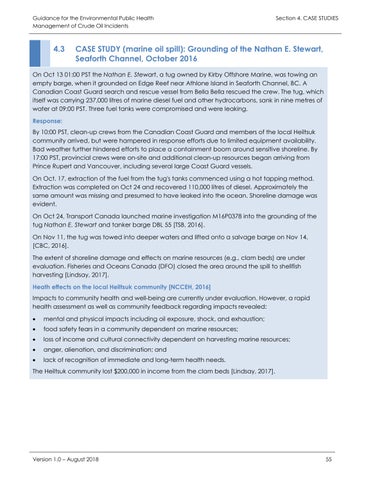Guidance for the Environmental Public Health Management of Crude Oil Incidents
4.3
Section 4. CASE STUDIES
CASE STUDY (marine oil spill): Grounding of the Nathan E. Stewart, Seaforth Channel, October 2016
On Oct 13 01:00 PST the Nathan E. Stewart, a tug owned by Kirby Offshore Marine, was towing an empty barge, when it grounded on Edge Reef near Athlone Island in Seaforth Channel, BC. A Canadian Coast Guard search and rescue vessel from Bella Bella rescued the crew. The tug, which itself was carrying 237,000 litres of marine diesel fuel and other hydrocarbons, sank in nine metres of water at 09:00 PST. Three fuel tanks were compromised and were leaking. Response: By 10:00 PST, clean-up crews from the Canadian Coast Guard and members of the local Heiltsuk community arrived, but were hampered in response efforts due to limited equipment availability. Bad weather further hindered efforts to place a containment boom around sensitive shoreline. By 17:00 PST, provincial crews were on-site and additional clean-up resources began arriving from Prince Rupert and Vancouver, including several large Coast Guard vessels. On Oct. 17, extraction of the fuel from the tug's tanks commenced using a hot tapping method. Extraction was completed on Oct 24 and recovered 110,000 litres of diesel. Approximately the same amount was missing and presumed to have leaked into the ocean. Shoreline damage was evident. On Oct 24, Transport Canada launched marine investigation M16P0378 into the grounding of the tug Nathan E. Stewart and tanker barge DBL 55 [TSB, 2016]. On Nov 11, the tug was towed into deeper waters and lifted onto a salvage barge on Nov 14. [CBC, 2016]. The extent of shoreline damage and effects on marine resources (e.g., clam beds) are under evaluation. Fisheries and Oceans Canada (DFO) closed the area around the spill to shellfish harvesting [Lindsay, 2017]. Heath effects on the local Heiltsuk community [NCCEH, 2016] Impacts to community health and well-being are currently under evaluation. However, a rapid health assessment as well as community feedback regarding impacts revealed: •
mental and physical impacts including oil exposure, shock, and exhaustion;
•
food safety fears in a community dependent on marine resources;
•
loss of income and cultural connectivity dependent on harvesting marine resources;
•
anger, alienation, and discrimination; and
•
lack of recognition of immediate and long-term health needs.
The Heiltsuk community lost $200,000 in income from the clam beds [Lindsay, 2017].
Version 1.0 – August 2018
55







